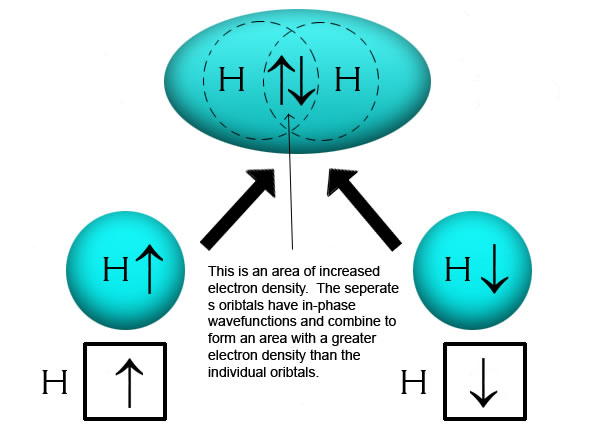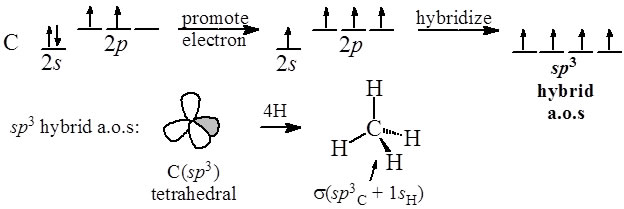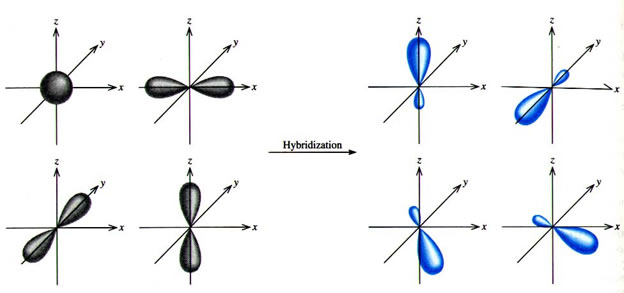What Spatial Arrangement of Charge Clouds Corresponds to Sp3 Hybridization
Hybridization
The content that follows is the substance of General Chemistry Lecture 35. In this lecture we Innovate the concepts of valence bonding and hybridization.
Valence Bond Theory
The Valence Bond Theory is the get-go of 2 theories that is used to depict how atoms grade bonds in molecules. In this theory we are strictly talking about covalent bonds.
According to the theory, covalent (shared electron ) bonds form betwixt the electrons in the valence orbitals of an atom by overlapping those orbitals with the valence orbitals of another cantlet.

When the bonds form, information technology increases the probability of finding the electrons in the infinite between the two nuclei.
There are ii different types of overlaps that occur: Sigma (σ) and Pi (π)
Sigma (σ) Bonds form betwixt the two nuclei as shown above with the majority of the electron density forming in a straight line betwixt the two nuclei. I often refer to this as a "head-to-head" bail.
Pi (π) Bonds form when two un-hybridized p-orbitals overlap. This is what I call a "side-by-side" bond.

Pi (π) Bond
In order to overlap, the orbitals must match each other in energy. The process by which all of the bonding orbitals go the aforementioned in free energy and bond length is chosen hybridization.
Hybridization
Permit's start this word by talking near why we need the energy of the orbitals to be the aforementioned to overlap properly.
Let's look at the bonds in Methane, CH4
The Carbon in methane has the electron configuration of 1sii2s22ptwo. According to Valence Bond Theory, the electrons institute in the outermost (valence) shell are the ones nosotros volition utilize for bonding overlaps. This will be the 2s and 2p electrons for carbon.
As yous know, p electrons are of college free energy than s electrons. This means that the two p electrons will brand shorter, stronger bonds than the two southward electrons right? But this is not what we meet. We meet a methane with four equal length and strength bonds. And then how do we explain this? Simple: Hybridization

1 of the s orbital electrons is promoted to the open p orbital slot in the carbon electron configuration and then all four of the orbitals become "hybridized" to a uniform energy level as 1s + 3p = 4 sp3 hybrid orbitals.

Identifying Hybridization in Molecules
Figuring out what the hybridization is in a molecule seems similar it would be a difficult process only in actuality is quite simple. Considering hybridiztion is used to make atomic overlaps, cognition of the number and types of overlaps an cantlet makes allows united states of america to make up one's mind the degree of hybridization it has. In other words, you lot only have to count the number of bonds or lone pairs of electrons effectually a central atom to determine its hybridization.
The post-obit rules give the hybridization of the fundamental atom:
i bond to another atom or lonely pair = s (not really hybridized)
2 bonds to another atom or lone pairs = sp
3 bonds to another atom or lone pairs = sp2
iv bonds to some other atom or lonely pairs = sp3
5 bonds to another atom or lone pairs = sp3d
6 bonds to another cantlet or lone pairs = sp3dtwoThis Video Explains information technology further:
What are the hybridizations for each of the cardinal atoms in the post-obit molecule?
As you can see from the case above, assigning the hybridization to each central atom is easy as long as yous can count to half-dozen. What is really cool about the hybridization is that each hybridization corresponds to an electron pair geometry. So if you know the hybridization of an cantlet yous automatically know its EPG.
For due south and sp hybridized central atoms the only possible molecular geometry is linear, correspondingly the merely possible shape is also linear:
For sp2 hybridized key atoms the but possible molecular geometry is trigonal planar. If all the bonds are in place the shape is also trigonal planar. If there are only two bonds and one alone pair of electrons property the place where a bond would be then the shape becomes bent.
For sp3 hybridized central atoms the only possible molecular geometry is tetrahedral. If all the bonds are in place the shape is too tetrahedral. If there are just three bonds and one lone pair of electrons belongings the place where a bail would be then the shape becomes trigonal pyramidal, 2 bonds and 2 lone pairs the shape is bent.
For sp3d hybridized key atoms the only possible molecular geometry is trigonal bipyramidal. If all the bonds are in place the shape is also trigonal bipyramidal. If there are only four bonds and one lone pair of electrons holding the place where a bond would be and so the shape becomes see-saw, 3 bonds and 2 alone pairs the shape is T-shaped, any fewer bonds the shape is so linear.
For sp3dtwo hybridized central atoms the simply possible molecular geometry is Octahedral. If all the bonds are in place the shape is likewise Octahedral. If there are only 5 bonds and i lone pair of electrons holding the place where a bond would exist and so the shape becomes Square pyramid, 4 bonds and 2 lone pairs the shape is square planar, 3 bonds and 3 solitary pairs the shape is T-shaped. Any fewer bonds the shape is then linear:
Source: https://chem.fsu.edu/chemlab/chm1045/hybridization.html